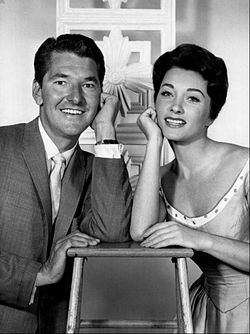Video Village
| Video Village | |
|---|---|

Jack Narz and Joanne Copeland, 1960.
|
|
| Presented by |
Jack Narz (1960) Red Rowe (1960, substitute) Monty Hall (1960-1962) |
| Narrated by | Kenny Williams |
| Country of origin | United States |
| No. of seasons | 2 |
| No. of episodes | 12 (1960 primetime) 501 (1960-1962 daytime) |
| Production | |
| Producer(s) | Merrill Heatter and Bob Quigley (Heatter-Quigley Productions) |
| Running time | 30 Minutes |
| Release | |
| Original network | CBS |
| Picture format | Black-and-white |
| Audio format | Monaural |
| Original release | July 1, 1960 – July 16, 1962 |
Video Village is an American television game show produced by Heatter-Quigley Productions which aired on the CBS network in daytime from July 11, 1960, to June 15, 1962, and in primetime from July 1 to September 16, 1960.
It was notable for the use of its unique "living board game" concept and for premiering soon after the quiz show scandals.
Jack Narz served as the host (introduced on-air as "the Mayor") from the show's premiere until September 9, 1960, after which he departed for personal reasons. Red Rowe filled in as Mayor for the week of September 16 (including the final nighttime episode); the following Monday, Monty Hall replaced him and hosted through the remainder of the show's run.
Kenny Williams served as the announcer (the "town crier") throughout the show's run. Joanne Copeland (later to become the second Mrs. Johnny Carson) served as the show's original hostess during its time originating from New York City. Shortly after Hall joined the show and Heatter-Quigley moved the show to CBS Television City in Hollywood, California, Copeland was replaced by Eileen Barton.
Two contestants played the role of tokens on a human-size game board with three streets: Money Street, Bridge Street and Magic Mile. Players advanced according to the roll of a large six-sided die in a chuck-a-luck, rolled on the sidelines by a partner (almost always a spouse or boyfriend/girlfriend) and called out by announcer Williams. After Video Village moved to California, the die was replaced by an electric randomizer. Any time a player landed on the space their opponent was on, they could either take an extra turn or force their opponent to return to the beginning of that street.
The squares changed throughout the show's run, but some of the more notable ones included:
The first contestant to reach either of the two "Finish" spaces (they had to do so by an exact roll) won the game and the right to return to play in the next game. Both contestants kept the cash and prizes they accumulated.
...
Wikipedia
